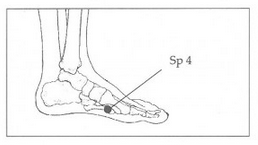Liang Gu, Public Health in China, Summer 2013
This is a post about my experience in Traditional Chinese Medicine classes. For other parts of the study abroad TCM experience, please refer to:
TCM Field Trips and Herb Collecting
The TCM class replaced the Public Health in China class that took place on the first month abroad. The TCM class will last for about 4 weeks and counts as 1 credit towards the Global Health minor. The class usually meets 4-5 times a week in the afternoon, and 1 or 2 of those days will be a field-trip (sometimes to the TCM museum, sometimes to the Beida medical school). The professors rotate to teach different aspects of TCM, and at the end of each professor’s rotation will be an assignment to complete before the end of the program (usually an open-ended essay).
In class we learned the different techniques of TCM, including acupuncture and moxibustion (针灸), massage (推拿), cupping (拔罐儿), and Qi Gong (气功).
ACUPUNCTURE AND MOXIBUSTION
Our acupuncture and moxibustion unit was very hands-on; immediately after walking into class we observed that our professor had a toolkit with him with mysterious contents. Halfway through class he opened it and took out some acupuncture needles. That’s when I knew things were about to get interesting.
He gave us a brief history of acupuncture including the tools that were used back in the days (it makes me cringe to see how thick and dull the needles used to look like), and the theory behind acupuncture. TCM established the body’s theoretical model for acupuncture – 12 regular meridians, 8 extra meridians, 15 collaterals, and 361 extra meridian points could all be targets for acupuncture. Moxibustion, on the other hand, uses a lit moxa stick to hover over specific areas. The moxa produces a gentle heat that warms up the flow of Qi.
Not long into class, the stabbing and burning began.
Not to worry – it was all voluntary and for the sake of learning! He showed us a few key acupuncture points and what they were good for. I myself received a needle to my Zu San Li, an acupuncture point 3 inches down from my kneecap because I was complaining of lacking energy. The professor inserted the needle first shallow, then deep, and after wiggling it around, I felt strange numbing sensations on my scalp. After the needle I didn’t feel sleepy anymore – but that may have been a natural response to getting stabbed! Several other students also volunteered and the response was mostly positive.
Seeds were used to apply acu-pressure to the ear; parts of the ear also corresponded to various parts of the body, and specific pressure on the ear could have remedial effects.
The interesting thing is, the ticklings sensation from the acupuncture is felt not locally, but at another distant part of the body. However, only about 60-80% of Qi channels are close to nerves, and there is no visible evidence of the channels themselves. This is known as the meridian phenomenon. Perhaps future research will elucidate this aspect of TCM.
MASSAGE (TUI NA)
Next we were introduced to the therapeutic massages, or Tui Na. Tui Na literally translates to “push, pick” or “push, pull.” Tui Na in general refers to the massage, but there are also specific techniques within Tui Na, such as kneading, brushing, rolling, pressing, pinching, hitting, and vibrating. Tui Na also targets the meridians and the places where Qi accumulates in the body in an effort to free up the flow of Qi and to reduce Qi stagnation.
Pro-tip: Here are some of the most useful pressure points I’ve learned about. If you want to stop hiccups quickly, find this spot on your wrist and apply medium to heavy pressure to it for about 20-30 seconds.
If you get a head-ache, apply pressure here
If you have a stomachache, apply pressure here:

If you feel tired, apply pressure here or here (about 2 inches below your knee)
CUPPING
We were also briefly introduced to cupping, a technique that uses the vacuum generated by the air cooling inside of a cup to apply suction to certain parts of the body. The cupping unit was more of a show-and-tell, with our professor performing the technique at the clinic on volunteers as she talked. The theory behind cupping is more or less the same as acupuncture and moxybustion, to free up the flow of Qi and prevent blood stagnation.
QI GONG
Finally, we were introduced to the breathing exercises of Qi Gong, which has its foundation in Chinese martial arts. It attempts to align the breathing through movement and meditation to foster healing. If you ever wake up at 6AM and decide to walk by the lake or to a park, you will witness lots of people, especially the elderly, practicing Qi Gong. In class we followed a video showing us the forms and movements of some basic stances of Qi Gong. Our professor enthusiastically practiced alongside us.















[…] NU in China « Traditional Chinese Medicine Field Trips Traditional Chinese Medicine Classes » […]
[…] TCM Class […]